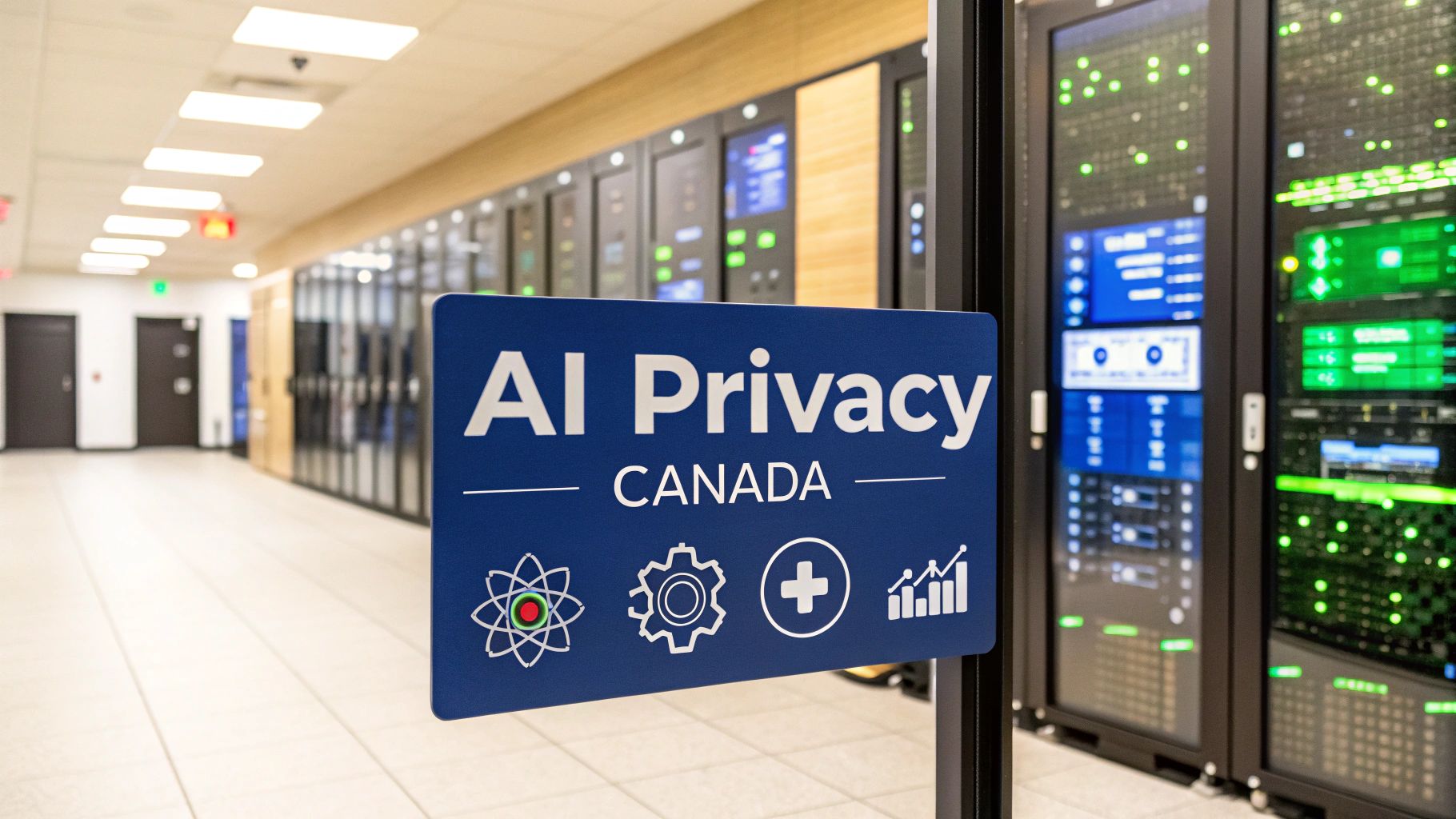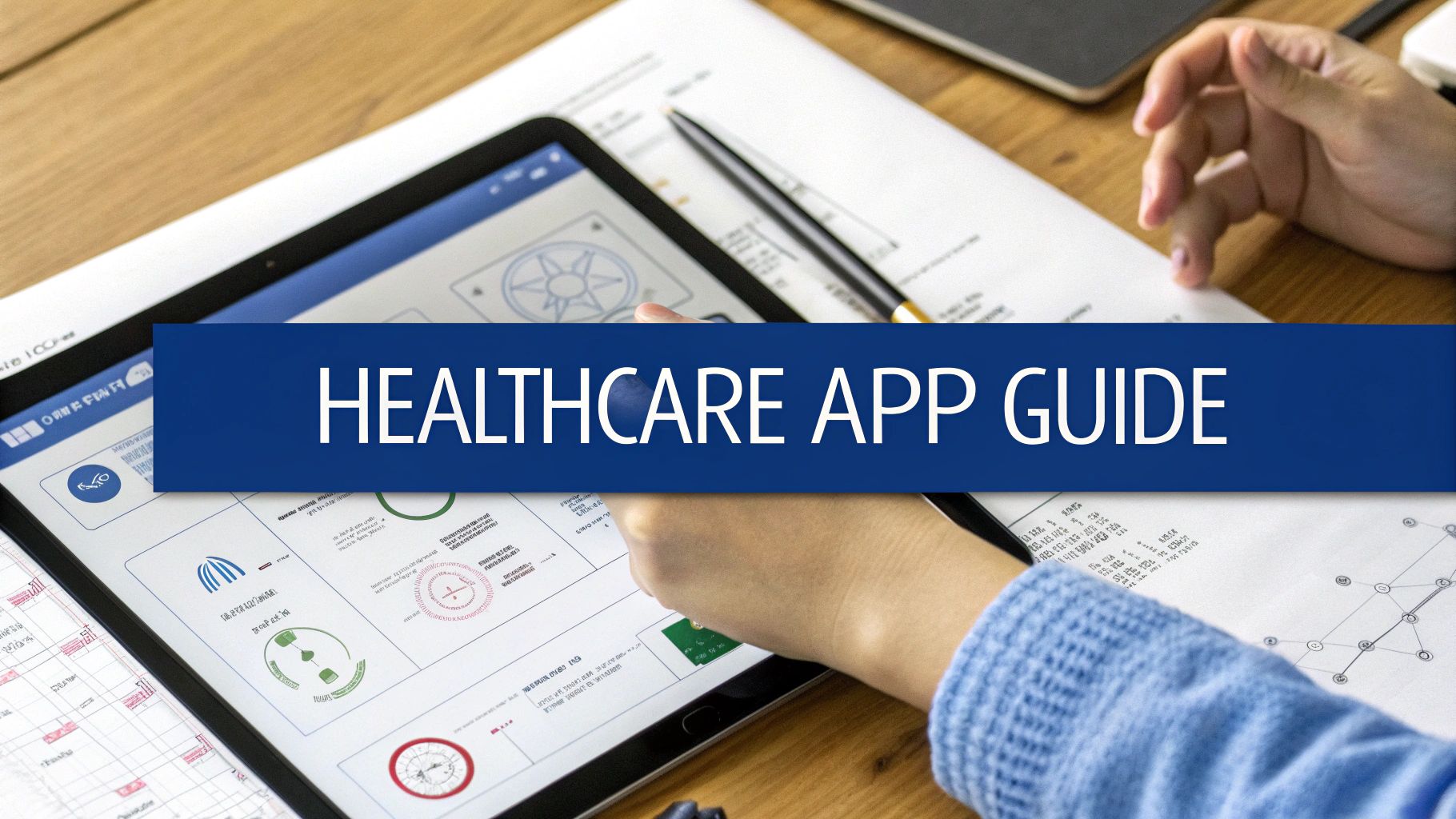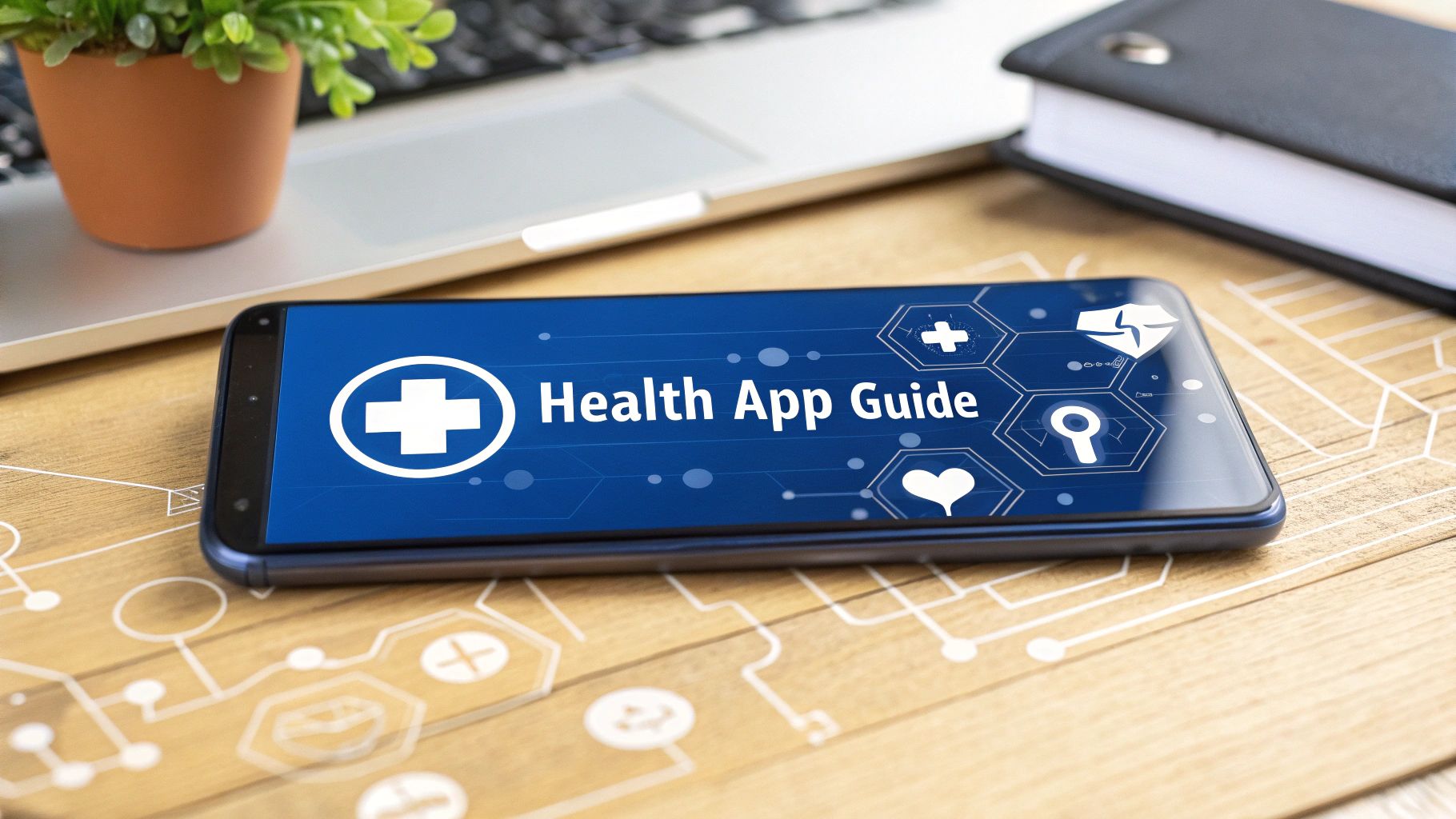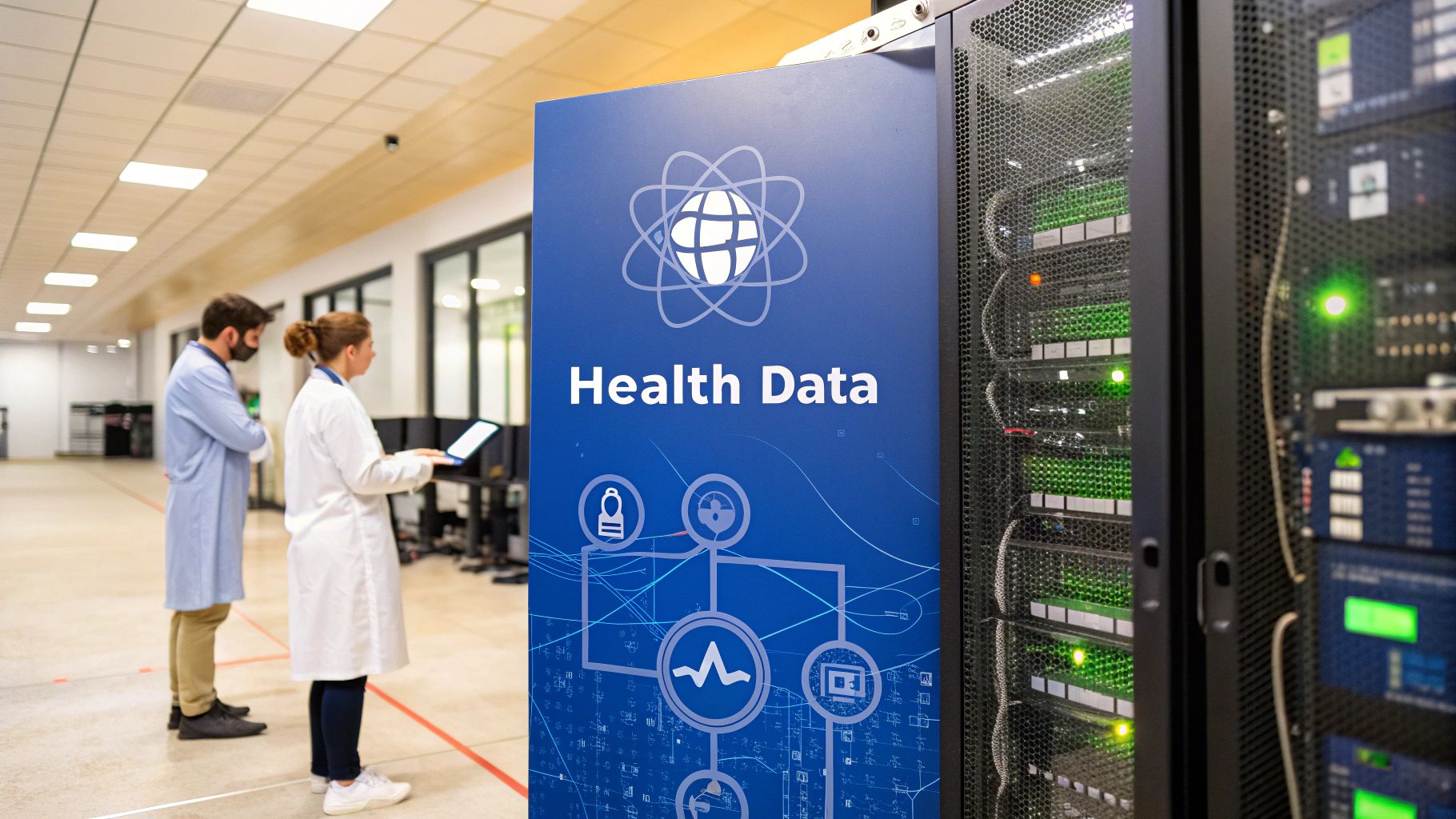Artificial intelligence is fundamentally changing Canadian healthcare, bringing incredible tools for diagnostics and personalized medicine right to our fingertips. But with this great power comes a great responsibility, and a whole new set of challenges for protecting sensitive patient information. It's a delicate balancing act between pushing innovation forward and upholding privacy.
The real challenge is making sure these sophisticated AI systems play by Canada's very strict data protection rules while still delivering on their promise to make us all healthier.
The New Frontier of AI and Canadian Patient Privacy
We're at a fascinating crossroads where artificial intelligence and patient data meet, and it’s a make-or-break moment for our healthcare system. On one hand, AI in healthcare gives us the power to analyze incredibly complex medical information, spot disease outbreaks before they happen, and tailor treatments to an individual's unique needs.
On the other hand, it opens up new vulnerabilities. If we're not careful, we risk eroding the public's trust. So for healthcare providers and their tech partners, the mission is clear: how do we get all the benefits of AI in healthcare without sacrificing a person’s fundamental right to privacy?
This tension between technology and trust is really the heart of the matter. People are hopeful, seeing the potential for better care, but they’re also understandably cautious about who is handling their most personal information. This isn't just a legal checkbox exercise; it's about building an ethical foundation that always puts the patient first.
The infographic below paints a clear picture of this dynamic, showing how AI, privacy rules, and patient trust are all deeply connected.
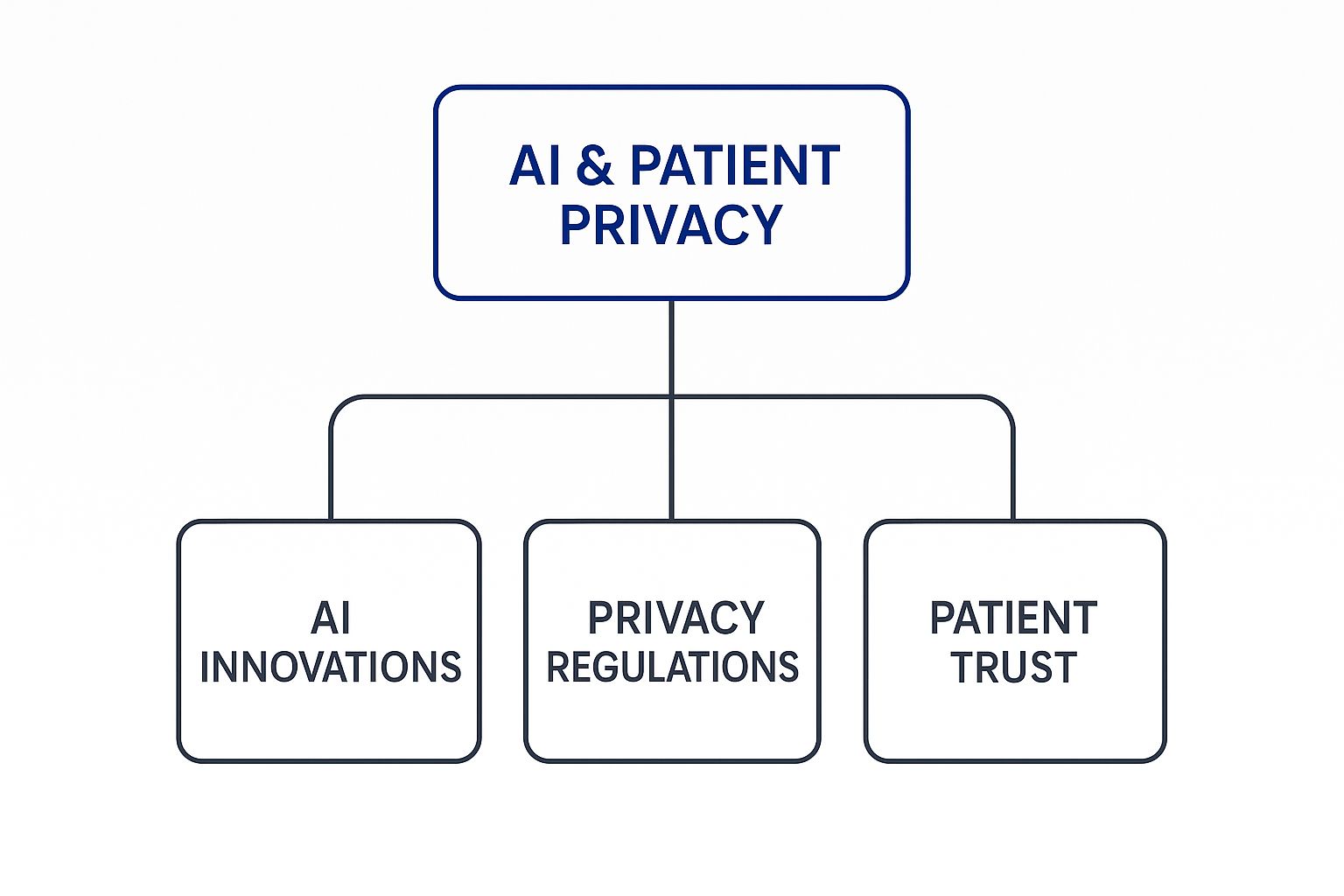
As you can see, getting this right means finding a balance where powerful technology is guided by smart regulations and a genuine commitment to earning and keeping the public's confidence.
Core Tensions in the AI-Health Ecosystem
Right at the centre of this new landscape, there are a few key pressures that every organization needs to manage. Successfully navigating them is a must for anyone implementing AI in Canadian healthcare.
-
Innovation vs. Regulation: AI technology is moving at lightning speed, often much faster than our laws can keep up. This leaves a bit of a grey area where organizations have to apply long-standing privacy principles to brand-new tech, which demands a thoughtful and proactive approach.
-
Data Utility vs. Anonymity: For an AI to learn, it needs a huge amount of data. The problem is, the old methods of "anonymizing" that data are starting to look shaky. New research shows that sophisticated AI can actually re-identify individuals from supposedly anonymous datasets, which pulls the rug out from under a key privacy safeguard.
-
Automation vs. Human Oversight: AI can automate tasks that would take a human ages to complete, but it’s not infallible. The risk of bias or outright error is real. That’s why having a human in the loop, someone to validate AI-driven insights and take responsibility, is absolutely critical and a growing focus for regulators.
The Critical Role of Public Trust
At the end of the day, none of this works without patient trust. Research from the University of Alberta hit the nail on the head: one of the public's biggest fears is that private companies will misuse or sell their personal health information. This is a huge hurdle.
To get past it, transparency is everything.
Patients need to feel certain that their data is secure, that it's being used ethically, and that it's actually helping improve health outcomes, all without putting them at risk. Building that trust is a team effort requiring clear communication, rock-solid security, and real accountability.
This isn't just about backend systems. As we explored in our data privacy adoption guide, even patient-facing tools like chatbots need to be built with privacy as a core feature from the very beginning. This commitment is the foundation for the future of AI in Canadian medicine. Now, let's dig into the legal landscape you'll need to navigate to make it happen.
Navigating Canada’s Health Privacy Regulations
Before you can even think about deploying AI in Canadian healthcare, you have to know the rules of the road. Getting this right is fundamental to building patient trust and ensuring your project succeeds. Canada’s legal framework for health data isn’t a single, simple document; it’s a multi-layered system.
Think of it like this: federal law sets the baseline for the whole country, but then each province adds its own specific, and often stricter, layers of protection on top.
At the federal level, the main piece of legislation is the Personal Information Protection and Electronic Documents Act (PIPEDA). This is the law that governs how private-sector organizations collect, use, and share personal information in their commercial activities. While it has a broad reach, it’s the foundational layer for any conversation about data privacy in Canadian healthcare.
PIPEDA isn't just a dense legal text; it’s actually built on 10 fair information principles. These are practical, common-sense guidelines that create a blueprint for handling data responsibly.
The 10 Fair Information Principles of PIPEDA
When you’re introducing something as complex as an AI system, these principles become your North Star for data governance.
-
Accountability: Someone in your organization must be officially in charge of protecting personal information. You can't just hope for the best.
-
Identifying Purposes: You have to be crystal clear about why you’re collecting personal information, and you need to state this upfront. No surprises.
-
Consent: People must know what they're agreeing to. You need their informed consent to collect, use, or share their personal data.
-
Limiting Collection: Collect only what you absolutely need for the purpose you’ve already identified. Less is more.
-
Limiting Use, Disclosure, and Retention: Once you have the data, you can't just use it for a new purpose without getting fresh consent. And don't hang onto it forever, only for as long as necessary.
-
Accuracy: The information needs to be accurate, complete, and current enough for its intended purpose.
-
Safeguards: You must protect the data with security measures that match how sensitive the information is.
-
Openness: Be transparent. Your policies for managing data should be readily available and easy to understand.
-
Individual Access: People have a right to know what information you have about them and to access it.
-
Challenging Compliance: You must have a straightforward process for people to raise concerns about how you’re handling their data.
While PIPEDA sets the national standard, it's just the starting point. To truly get the full picture, you need a solid grasp of the broader Canadian data privacy laws as well. That's because, in Canada, healthcare is primarily a provincial matter, which brings us to the next layer of regulation.

Provincial Health Legislation: The Next Layer
Many provinces have passed their own health-specific privacy laws that are considered "substantially similar" to PIPEDA. Where these laws exist, they take precedence over the federal act for health information handled within that province.
For example, Ontario has its Personal Health Information Protection Act (PHIPA), and Alberta has the Health Information Act (HIA). These acts lay down much more detailed rules for "health information custodians", think hospitals, clinics, and pharmacies. They often come with tougher requirements for things like patient consent, data security, and what to do if a breach happens.
This dual-layer system means you first have to figure out which laws apply where. If your organization operates across the country, you could be dealing with PIPEDA in one province and a specific provincial health act in another.
This complexity is precisely why a one-size-fits-all compliance strategy just won't work. For anyone looking to innovate with AI in Canadian healthcare, mastering this legal landscape is the absolute bedrock of doing business responsibly. As we'll see, these principles become even more crucial when you start to manage the unique risks that AI brings to the table.
The Unique Privacy Risks AI Introduces
Bringing AI into healthcare isn't like a simple software update; it completely rewrites the rules of risk. Artificial intelligence brings new, complicated privacy challenges to the table that our traditional frameworks just weren't built for. To navigate the future of AI in healthcare responsibly, we first need to get a handle on these specific vulnerabilities.
One of the biggest hurdles is what’s known as the "black box" problem. Many advanced AI models, especially deep learning networks, work in ways that are so complex, even the people who designed them can't fully trace how they reached a particular decision. It’s like a brilliant doctor who can spot a rare disease but can't quite put into words the exact thought process that led to the diagnosis. This lack of transparency creates a huge accountability problem when an AI's decision affects a patient's health.

This kind of opacity is a major source of public distrust. At its core, healthcare data privacy in Canada is all about openness and consent. But how can a patient give meaningful consent to a procedure that nobody can clearly explain? That's a question every healthcare organization needs to answer.
The Amplification of Bias and Inequity
Algorithmic bias is another massive risk. An AI model is only as smart or as fair as the data it’s trained on. If the historical data fed into the system reflects existing societal biases, and it often does, the AI won’t just learn these biases. It can magnify them across the entire system.
Think about it like this: an AI is a student learning from a textbook full of subtle prejudices. The student will absorb those prejudices and apply them, only at a speed and scale a human never could. If an AI is trained on data that underrepresents certain populations, it might produce less accurate diagnoses or poorer treatment plans for those groups, making existing health inequities even worse.
The real danger here is that these biases get hardwired into automated systems, cloaked in a false sense of scientific objectivity. Fixing this isn't easy; it demands meticulous data curation and constant audits to ensure fairness in AI-driven healthcare.
This isn't just a theoretical concern. It's a real-world problem with the potential to cause serious harm to marginalized communities and further erode their trust in the healthcare system.
Re-Identification and the Myth of Anonymity
For a long time, the go-to method for protecting privacy in health research was to "anonymize" data by removing things like names and addresses. AI has completely upended that approach. Powerful algorithms can now sift through multiple, supposedly anonymous datasets, find connections, and piece together enough information to re-identify individuals.
Suddenly, data that was considered safe is now at risk. This is a huge issue when we talk about AI in healthcare data privacy in Canada. The ability to connect an "anonymous" health record with other publicly available data is a serious threat to patient confidentiality. To get ahead of these new threats, applying essential cybersecurity risk management techniques is no longer optional; it's critical.
These technical challenges directly shape how the public feels. A national survey from Canada Health Infoway revealed a major trust gap. While 49% of Canadians feel digital health services improve their care, only 38% actually trust healthcare organizations to keep their data safe, and that number drops to a mere 28% for technology companies. When private companies are involved, people's comfort level with sharing health data plummets, with 36% pointing to a lack of transparency as their biggest worry. You can explore more findings in the digital health privacy survey to better understand Canadian perspectives. This data makes one thing crystal clear: transparent governance isn't just a box to check for compliance, but the only way to earn the public's trust.
A Practical Framework for AI Privacy Compliance
Moving from theory to practice means having a clear, actionable plan. A solid strategy for AI in healthcare data privacy in Canada isn't about scrambling to fix problems after they surface. It’s about weaving privacy into the very fabric of your systems from the get-go. This proactive mindset is what separates leaders in a field where trust is everything.
The foundation of any good framework is the Privacy Impact Assessment (PIA). Many organizations treat PIAs like a final bureaucratic checkbox to tick before a project goes live. That’s a mistake. Instead, think of a PIA as a strategic tool. It should be used right at the beginning of development to map out how data will flow, spot potential privacy risks, and figure out how to solve them before a single line of code is even written.
Embracing Privacy by Design
The most effective way to approach this is through Privacy by Design (PbD), a concept that actually originated in Ontario and has since been adopted worldwide. PbD isn't a rigid checklist; it’s a philosophy. It's about building privacy principles directly into the architecture of your AI systems, making privacy the default setting, not a last-minute add-on.
Putting PbD into action involves a few core practices:
-
Proactive, Not Reactive: Get ahead of privacy issues before they become problems. This means running PIAs early and treating them as living documents, not a one-and-done task.
-
Privacy as the Default: Your systems should automatically protect personal information. Users shouldn't have to navigate complex menus to secure their data; the most private settings should be the standard right out of the box.
-
Full Functionality: Privacy shouldn't cripple your system's performance. The goal is a win-win scenario where you achieve both, proving that strong security and a great user experience can go hand-in-hand.
When you adopt this mindset, compliance becomes a natural result of smart design, not a constant battle.
Actionable Strategies for Implementation
With the PbD philosophy as our guide, let's look at some practical steps for any organization using AI in healthcare.
First up is data minimization. The principle is simple but incredibly powerful: only collect, use, and keep the personal health information that is absolutely essential for the specific task you’ve defined. If your AI model can be trained effectively without a certain piece of data, then that data should never be collected in the first place. This immediately shrinks your organization's risk profile.
Next, you need to use strong de-identification and anonymization techniques. As we've established, old-school methods of scrubbing data just don't cut it anymore. Modern approaches like k-anonymity or differential privacy offer mathematical guarantees that make it far more difficult for someone to be re-identified from a dataset.
It's also critical to establish clear lines of accountability. Every AI system that touches health data needs a designated owner, a real person who is responsible for its privacy compliance, ethical oversight, and performance. This ensures there’s always a human in the loop who is ultimately answerable for what the system does.
This proactive approach isn't just about following the rules; it's a real competitive advantage. Organizations that put privacy first build deeper, more meaningful trust with their patients and partners. This holds true across different sectors. For a closer look at how these ideas work in another industry, you can learn more about AI and data privacy in insurance.
Finally, a robust governance structure is essential. This is the human oversight that keeps the technology in check. An internal ethics board or a dedicated AI governance committee can provide that crucial supervision, review algorithms for bias, and make sure your systems align with both regulations and your organization's core values. This structure turns abstract principles into concrete practice, guaranteeing that your use of AI always puts the patient's best interests first.
How New Technologies are Solving Privacy Challenges
Innovation isn't just creating privacy problems; it's also delivering some powerful solutions. While the risks that come with AI are very real, a new set of tools called Privacy-Enhancing Technologies (PETs) is starting to tip the scales back in favour of confidentiality. These tools are built specifically to protect personal information, giving us a path to advance AI in healthcare without sacrificing patient trust.
This marks a huge shift from a defensive stance on privacy to a proactive one. Instead of just putting up digital walls around sensitive data, PETs fundamentally change how that data can be used, shared, and analysed. It means organizations can collaborate and uncover incredible insights while the raw, identifiable information stays securely locked down.
The Power of Federated Learning
One of the most promising PETs on the scene is Federated Learning. Think about it: an AI model needs to learn from patient data scattered across multiple hospitals in different provinces. The old way of doing things would be to pool all that sensitive data into one central database, creating a massive security risk and a compliance nightmare.
Federated Learning flips that entire model on its head.
The AI model itself "travels" to each hospital's local server to learn from the data right where it lives. The patient data never leaves the hospital's secure network. Only the learnings, the anonymized model updates, are sent back to a central server to improve the main algorithm.
It’s a bit like a team of doctors consulting on a tough case. They share their expertise and what they've learned, but they never pass around the actual patient files. This approach drastically cuts the risk of data breaches during transfer and storage, making it a game-changer for collaborative medical research across Canada.

Generating Privacy with Synthetic Data
Another groundbreaking technology is Synthetic Data. This is where an AI model studies a real patient dataset and then generates a completely new, artificial dataset that perfectly mimics the statistical patterns of the original. These synthetic records look and feel just like real data and can be used to train other AI models, but they contain absolutely no actual personal health information. This is a crucial development for AI in healthcare data privacy in Canada.
This technique completely severs the link between the training data and real people, which helps sidestep some of the trickiest compliance issues in healthcare data privacy in Canada.
Canadian institutions are already leading the charge here. For instance, the Children’s Hospital of Eastern Ontario (CHEO) is using AI to generate synthetic medical data from real patient records. This method allows researchers to share large datasets for training and analysis without the risk of anyone being re-identified. It can even simplify the traditional ethics board review process. You can read the full research on this privacy-preserving technique to see just how big an impact it's having.
Technologies like these show us a way forward. They prove that strong privacy and powerful innovation don't have to be opposing forces. Instead, they can work together to build a more effective, efficient, and trustworthy healthcare system for everyone.
The Future of Trustworthy AI in Canadian Healthcare
Looking ahead, the successful marriage of AI and healthcare really comes down to one thing: trust. The path forward isn't a straight line; it's a careful dance between innovators pushing the boundaries of technology, regulators working to protect patient rights, and the public, whose confidence is essential.
This isn't about choosing between cutting-edge tech and personal privacy. It's about building a system where they fundamentally support each other.
To get there, we have to stay ahead of a regulatory environment that's constantly shifting. We're already seeing potential updates on the horizon, like the proposed Consumer Privacy Protection Act (Bill C-27), which could bring in new rules for automated decision-making. These kinds of changes would directly shape how AI models are built, tested, and used in Canadian health, demanding more transparency and accountability from everyone involved.
This evolving landscape makes one thing crystal clear: having a strong internal governance structure is no longer optional. Just ticking the boxes for today's laws isn't enough. We need to be proactive.
The Rise of AI Ethics and Governance
A major trend shaping this future is the creation of dedicated ethics and governance committees within healthcare organizations. These groups are quickly becoming indispensable, tasked with overseeing how AI tools are brought into the fold and ensuring they're used responsibly and fairly for all patients. They act as the crucial bridge between the tech developers and the real world of patient-centred care.
These committees usually zero in on a few key areas:
-
Algorithmic Audits: They regularly put AI models under the microscope to find and fix biases that might accidentally deepen health inequities for marginalized communities.
-
Transparency Frameworks: They develop clear, understandable policies explaining how AI-driven decisions are made and how that information is shared with both doctors and patients.
-
Patient Engagement: They bring patients into the conversation, making sure their voices, perspectives, and concerns about how their data is used are actually heard and acted upon.
The core message is this: if we want a future where AI genuinely and safely improves patient lives, we need deep collaboration between the people building the tech, the providers using it, and the public it serves. Privacy can't be an afterthought.
Instead, we need to treat privacy as a foundational pillar of excellent patient care in this new era. As we've explored, there are incredible benefits of AI in Canadian healthcare, but we can only unlock them if we build on that solid foundation of trust.
This commitment to ethical innovation is key to navigating the complexities of AI in healthcare data privacy in Canada. Building this future means partnering with experts who live and breathe this intricate world.
Frequently Asked Questions About AI and Health Privacy
It's only natural to have questions when new technology like artificial intelligence starts to interact with something as personal as our health information. Let's clear up some of the most common ones about how this all works in Canada.
How is My Health Data Protected from AI Risks?
Think of it as a multi-layered defence. Your health data is shielded by a combination of federal and provincial laws, like PIPEDA in Ontario and similar legislation across the country. These laws aren't just suggestions; they legally require healthcare organizations to use robust security measures, be upfront about how your data is used, and get your consent first.
When AI enters the picture, these rules still apply, but with extra precautions. This means using smart techniques like data minimization (only using the absolute minimum data needed for a task) and thorough de-identification to strip out personal details. It’s all about making sure the core principles of healthcare data privacy in Canada are respected, no matter how advanced the technology gets.
Can AI Make Medical Decisions Without a Doctor?
Absolutely not. Right now, AI is best seen as a highly advanced assistant for doctors, not a replacement. A revealing study from Yale highlighted a major public concern: the fear of misdiagnosis and the loss of human oversight if AI were left to its own devices.
Because of this, ethical guidelines across Canada insist on having a "human in the loop." This means a qualified doctor or clinical expert is always the one to review an AI's suggestions, use their own judgment, and make the final call on your treatment. The AI provides insight; the human makes the decision.
What is Being Done to Prevent AI Bias in Healthcare?
This is one of the most important challenges, and it's getting a lot of attention. The biggest risk with AI in healthcare is that it could accidentally learn and amplify existing biases found in historical health data.
To combat this, organizations are getting proactive. They're carefully reviewing and cleaning up the data used to train AI models to make sure it reflects Canada's diverse population. Many are also setting up dedicated AI ethics committees to constantly test algorithms for fairness and ensure they don't lead to unequal care for different groups of people.
The core principle is that technology must serve all patients equitably. This commitment to fairness is fundamental to building trust in AI in healthcare data privacy in Canada and ensuring that innovation benefits everyone.
This hands-on approach is key to creating a digital health system we can all trust. If you're interested in the people behind this work, you can read more about us.
At Cleffex, we specialize in developing secure, compliant, and ethical AI solutions that empower healthcare providers while prioritizing patient trust. Contact us today to learn how we can help you navigate the future of health technology.
